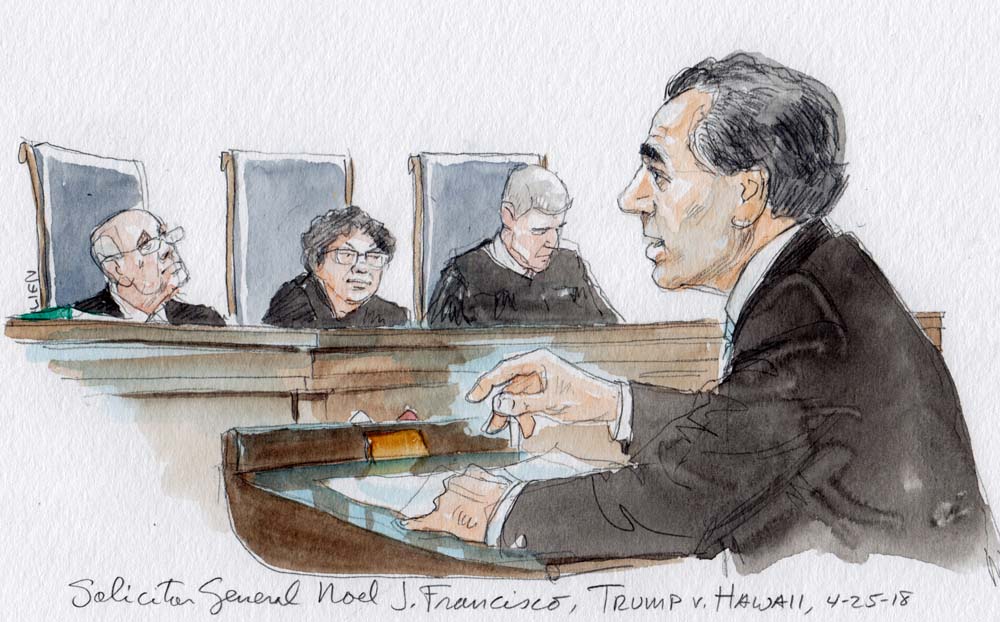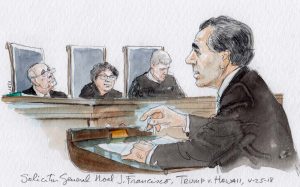Argument analysis: Travel ban seems likely to survive Supreme Court’s review


It has been nearly 15 months since President Donald Trump first issued an order that banned travel to the United States by nationals of seven countries, all of which have overwhelmingly Muslim populations. After lower courts blocked the government from enforcing both the original January 2017 order and a revised order that followed it in March 2017, Trump issued a new order last September. Today the Supreme Court heard oral argument on the legality of the September 2017 order, in one of the most anticipated sessions in recent memory. After over an hour of debate, a majority of the court (and perhaps even a solid one) appeared ready to rule for the government and uphold the order in response to concerns about second-guessing the president on national-security issues.

The September 2017 order at the center of today’s oral argument is similar, but not identical, to the two that preceded it. The January 2017 order imposed a 90-day ban on the entry of citizens from seven Muslim-majority countries – Iran, Iraq, Libya, Syria, Somalia, Sudan and Yemen – and put a 120-day hold on the admission of refugees, with an exception for refugees who were religious minorities in their home countries. After federal courts barred the government from implementing the order, the Trump administration went back to the drawing board. In March 2017, a revised order imposed a 90-day ban on the entry of citizens from six of the seven Muslim-majority countries included in the January order (Iraq was removed from the list) and suspended the entry of refugees for 120 days, this time without any exceptions for religious minorities. Lower courts barred the federal government from enforcing that order too, and the Supreme Court agreed in June 2017 to weigh in. But the justices took the case off their calendar after the March order expired and the president issued the order at the center of this case, which currently limits travel from seven countries: Libya, Iran, Somalia, Syria, Yemen, North Korea and Venezuela. (Chad was originally included in the September 2017 order, but has since been removed.)
Arguing on behalf of the Trump administration, U.S. solicitor general Noel Francisco emphasized that the September 2017 order was the result of a lengthy “world-wide multi-agency review,” which prompted the Department of Homeland Security to recommend that the president restrict travel to the United States by travelers from countries that had failed to meet minimum standards for providing information that can be used to vet those travelers.
Justice Ruth Bader Ginsburg interrupted Francisco, suggesting that federal immigration laws only allow the president to “suspend” the entry of travelers into the United States as a temporary remedy, to give Congress time to pass laws to address any problems.
Justice Sonia Sotomayor saw a different problem. In her view, Congress had already addressed the same problem that, according to Francisco, led the president to issue the order. Congress enacted a visa-waiver program, which allows the citizens of some countries to travel to the United States for up to 90 days without having to obtain a visa, it established a more stringent vetting procedure for citizens of other countries that do not meet the requirements for the waiver program and it added yet another layer of review for terrorist countries. Here, Sotomayor complained, the president wants to go beyond the limits that Congress has already set. Where does he get the authority to do that? she asked.
Francisco also had to grapple with concerns about statements made by the president, both on the campaign trail and after he took office, about banning Muslims from the United States, and whether those statements suggested that the president intended to discriminate against Muslims. Francisco insisted that the September 2017 order is “not a so-called Muslim ban”; if it were, he added, it would be the “most ineffective Muslim ban ever,” because it fails to target most Muslim countries.
But Justice Elena Kagan posed a hypothetical, asking Francisco to consider a scenario with an “out of the box president” (a characterization that drew laughs from the audience) who was a “vehement anti-Semite” before taking office. If during his presidency, he asked his cabinet to issue recommendations for a proclamation that would ban all travelers from Israel, would that violate the Constitution’s establishment clause, which bars the government from discriminating based on religion?
Francisco insisted that it would not, because the president could follow the cabinet’s advice if it cited a national security risk from Israeli travelers, no matter what might have been in his “heart of hearts.”
It wasn’t clear whether Kagan was convinced, but other justices – most notably Chief Justice John Roberts and Justice Samuel Alito – were clearly worried that a ruling for the challengers might entangle courts in second-guessing the president’s national-security determinations. Roberts led the way, asking attorney Neal Katyal, who represented the challengers, to imagine a scenario in which U.S. intelligence agencies tell the president that 20 Syrian nationals are planning to come to the United States with chemical weapons. Could the president ban all Syrians from coming to the United States, Roberts asked?

Katyal responded that such a ban would pass muster. He reasoned that it wouldn’t be discrimination based on nationality, which immigration laws prohibit, but instead would be an effort to address a fast-moving emergency. But in this case, he contrasted, the president’s first order restricting entry into the United States was issued 460 days ago, and the president has never asked Congress to act.
Alito later asked a similar question. Is there any situation, he queried, in which the threat of terrorism could be so severe that the scheme that Congress enacted would be inadequate to deal with the problem? Katyal agreed that there could be, but that response got him into hot water with Justice Anthony Kennedy. So the courts need to determine whether there is an emergency? Kennedy asked.
Kagan echoed Kennedy’s concern, observing to Katyal that the September 2017 order points to the important national-security issues at stake. How is the Supreme Court supposed to determine the legality of the president’s order, she asked, without evaluating whether those national-security interests are real?
More broadly, Alito seemed skeptical that, especially when the president’s tweets and statements about a Muslim ban are put aside, the president’s September 2017 order actually is a “Muslim ban.” There are dozens of Muslim countries, Alito pointed out, but the order only includes five of them, which collectively comprise a very small percentage of the world’s Muslim population. And there are other reasons – such as the failure to share information – that the five countries are included in the order, leading to a strong presumption that the order was not issued to discriminate against Muslims, Alito concluded.
Justice Stephen Breyer seemed to have a different concern. The September 2017 order leaves open the possibility that citizens of the countries included on the order could still come to the United States if they fall within one of the exceptions to the order or qualify for a case-by-case waiver. Although it was not entirely clear, Breyer seemed to be suggesting that, if the possibility of an exception or waiver is a real one, rather than simply “window dressing,” he might be willing to uphold the order.
Katyal tried to seize on this point, telling the justices that the federal government has not publicized the availability of waivers. And he cited the case of a 10-year-old Yemeni girl with cerebral palsy, who hoped to come to the United States for life-saving medical care that she could not obtain in war-torn Yemen but was denied a visa.
Francisco pushed back during his rebuttal, telling the justices that not only does the State Department publicize the waiver program, but consular offices also automatically consider whether a visa applicant is eligible for a waiver or an exception. Moreover, he added, the federal government has issued 430 waivers since the most recent order was issued in September 2017.
Francisco’s explanation and statistics came at the end of his rebuttal, during which the justices traditionally ask (relatively) few questions, so it’s not clear whether they mollified Breyer. In the end, the government may not get the votes of either Breyer or Kagan. But it’s worth remembering that, when the justices granted the government’s request last December to be able to enforce the full set of restrictions in the September 2017 order while its appeals moved forward, only two justices – Ginsburg and Sotomayor – publicly disagreed with that decision. That would have given the government reason to be optimistic, and today’s argument might have reinforced that optimism: Although it’s always risky to make predictions based on the oral argument, it’s difficult to see how Hawaii can pick up the five votes that it needs to strike down the president’s order.
The audience for today’s oral argument included a wide range of notables, from Hamilton creator Lin-Manuel Miranda to Republican Sen. Orrin Hatch of Utah (who appeared briefly to ask the justices to admit several Utah lawyers to the Supreme Court bar) and White House counsel Don McGahn – who sat next to Cecelia Marshall, the widow of the late Justice Thurgood Marshall. But just like the rest of us, all of those spectators will have to wait, almost certainly until the end of June, for the court’s decision.
This post was originally published at Howe on the Court.
Cases: Trump v. Hawaii
